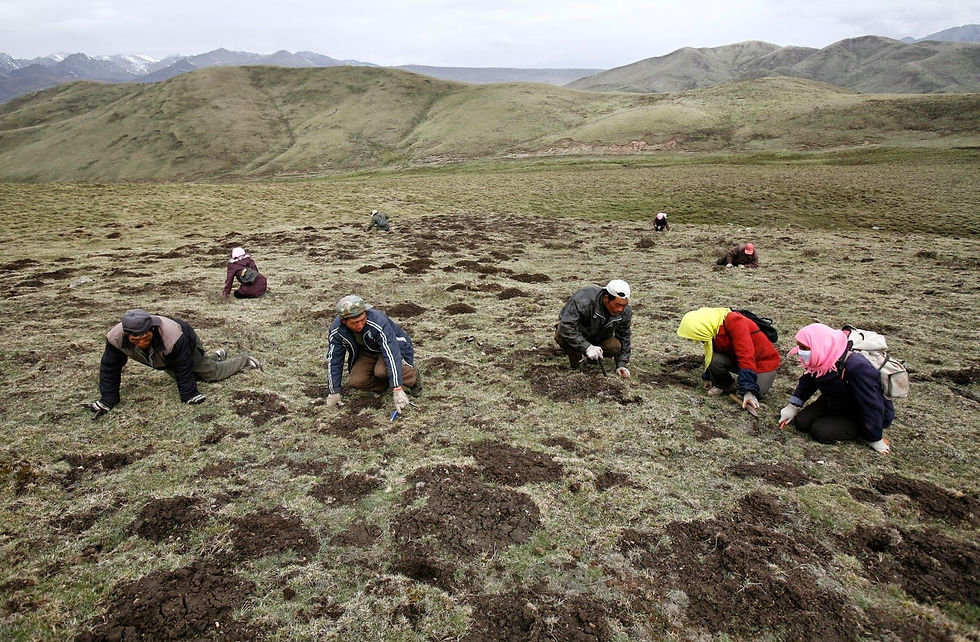Yarsagumba (Cordyceps sinensis): The Miracle Himalayan Mushroom with Incredible Healing Power
- Vivek Singh
- 7 days ago
- 4 min read
Yarsagumba, or Cordyceps sinensis, is one of nature's most fascinating treasures. This unusual fungus is not a regular plant or animal. It is a parasitic mushroom that grows on the larvae of ghost moths in the Himalayas. People in Nepal, Tibet, Bhutan, and Northern India find Yarsagumba high in the alpine meadows. It is prized as a natural medicine and is often called the "Himalayan Viagra" because it is said to have aphrodisiac properties.

For hundreds of years, Traditional Chinese and Tibetan Medicine (TCM) has used it as a natural way to boost stamina, immunity, vitality, and longevity.
A Mushroom Born from a Caterpillar
The life cycle of Yarsagumba is both strange and fascinating. In the summer, millions of tiny spores from this fungus infect ghost moth caterpillars that live underground. The fungus slowly eats the larva from the inside out, keeping the outside shell intact. In the spring, a dark brown fungal stalk grows out of the caterpillar's head. It is half insect and half plant.

People collect this rare mix by hand from high mountain slopes between 3,600 and 4,500 meters, mostly in India, Nepal and Tibet. People in the area call it "Keera Jadi" or "Keera Ghaas," which means "insect herb."
A Glimpse into History
The first written record of Yarsagumba comes from Tibet in the 15th century. In his book "An Ocean of Aphrodisiacal Qualities," Doctor Nyamnyi Dorje praised it.
During the Qing Dynasty in China (18th century), emperors used Cordyceps as a royal medicine. In 1993, though, it became famous around the world when a group of Chinese athletes broke several world records and said that eating Cordyceps regularly helped them stay strong.
This "Himalayan Gold" is now one of the most expensive natural medicines in the world, selling for tens of thousands of dollars per kilogram on the global herbal market.
Where It’s Found
Yarsagumba grows mostly in the Himalayas and the Trans-Himalayas.
Nepal (Dolpa, Jumla, Rukum, Mustang)
Yunnan and Tibet (China)
Bhutan and Northern India (Uttarakhand, Arunachal Pradesh, and Sikkim)
It grows well in pastures above 3,600 meters, where it shows up for a short time every spring after the snow melts.
What Makes Yarsagumba (Cordyceps sinensis) So Powerful?

There are dozens of bioactive compounds in Yarsagumba that scientists have found, including
Cordycepin (3'-deoxyadenosine): Anticancer, antiviral, and anti-inflammatory effects
Adenosine: Enhances energy transfer and cardiovascular well-being
Polysaccharides and β-glucans: Help the immune system and fight free radicals.
Ergosterol is a precursor to vitamin D and has anti-inflammatory properties.
Amino acids and sterols help repair tissues and keep hormones in balance.
These compounds together explain why Yarsagumba has been used to treat so many different health problems.
Proven Pharmacological Benefits of Yarsagumba
Contemporary pharmacological studies have validated numerous traditional applications of this fungus. Here are some of the most important scientifically studied benefits:
1. Protects the Heart
Yarsagumba (Cordyceps sinensis) lowers cholesterol, oxidative stress, and blood flow, all of which help the heart work better. It also has antiarrhythmic and vasodilating effects, which are good for heart health.
2. Boosts the Immune System
Polysaccharides and β-glucans in Cordyceps help the body fight infections and inflammation by making macrophages and natural killer cells work harder.
3. Fights Inflammation
It lowers pain and swelling naturally by stopping enzymes that cause inflammation, such as COX-2 and NF-kB.
4. Anti-Aging and antioxidants
Yarsagumba protects body cells from oxidative stress and premature aging by neutralizing harmful free radicals. It is said that eating it regularly can help you live longer and feel better.
5. Anticancer Potential
Cordycepin, a major part of Yarsagumba, has been shown to cause apoptosis, which means it can make cancer cells kill themselves. It also stops tumors from making new blood vessels, which slows down the spread of cancer.
6. It increases energy and stamina.
Athletes and mountaineers use Yarsagumba to help them use more oxygen and make more ATP, which makes them less tired and better able to keep going.
7. Aphrodisiac Effect
Yarsagumba is often called "Himalayan Viagra" because it boosts testosterone levels and blood flow, which boosts libido and sexual function.
8. Helps with depression and fatigue
It helps keep serotonin and dopamine levels in check, which makes you feel better, have more mental energy, and be better able to handle stress.
9. Lowers cholesterol and blood sugar
Its compounds help lower cholesterol, improve insulin sensitivity, and control how glucose is used in the body. This is beneficial for liver and metabolic health.
10. Protecting the Kidneys
Yarsagumba's bioactive compounds lower oxidative stress in the kidneys and have been used with regular medicines to keep them healthy.
The Human Connection—From Tradition to Science
Yarsagumba is more than just medicine for people in the Himalayas; it's a way of life. Every year, thousands of people go to high-altitude meadows to pick it by hand. But climate change and overharvesting are now putting its natural population at risk. This issue has led scientists to look into growing Cordyceps in labs for long-term production.
Modern Research & Future Prospects
Researchers are still looking into Cordyceps to see if it can help fight cancer, boost the immune system, and fight viruses. It was even used during the SARS outbreak in 2003 because it helps the immune system.
More clinical research is needed, though, to make standardized dosage forms and pharmaceutical-grade extracts that make the most of this natural wonder.
Conclusion
From ancient Tibetan highlands to modern scientific labs, Yarsagumba stands as a symbol of nature’s incredible healing power. Whether used as a traditional tonic or studied for cutting-edge medicine, this rare Himalayan fungus continues to bridge the gap between folk wisdom and modern pharmacology.
It’s not just a mushroom—it’s a story of life, survival, and symbiosis that captures the essence of nature’s genius.










Comments